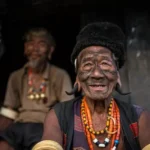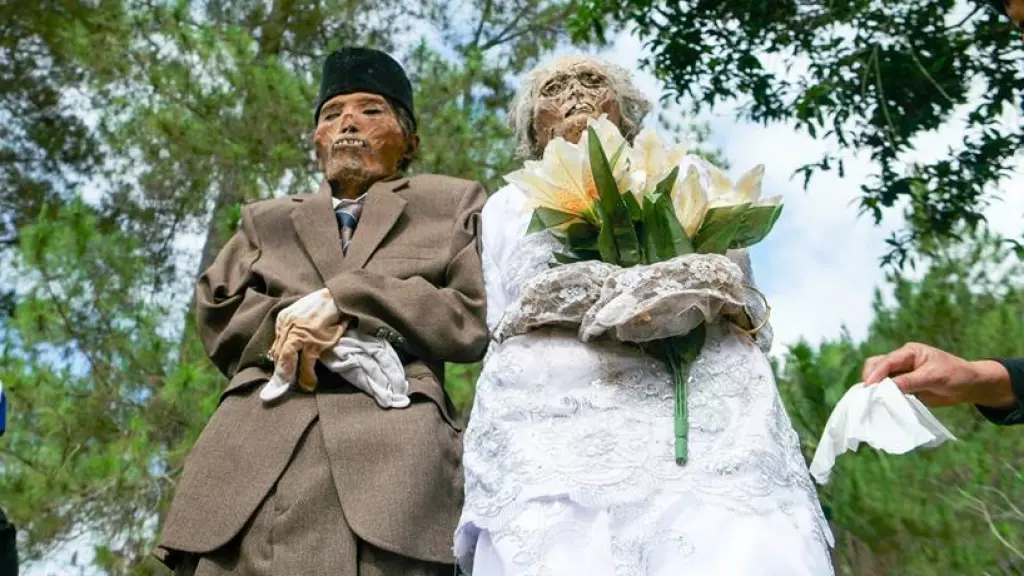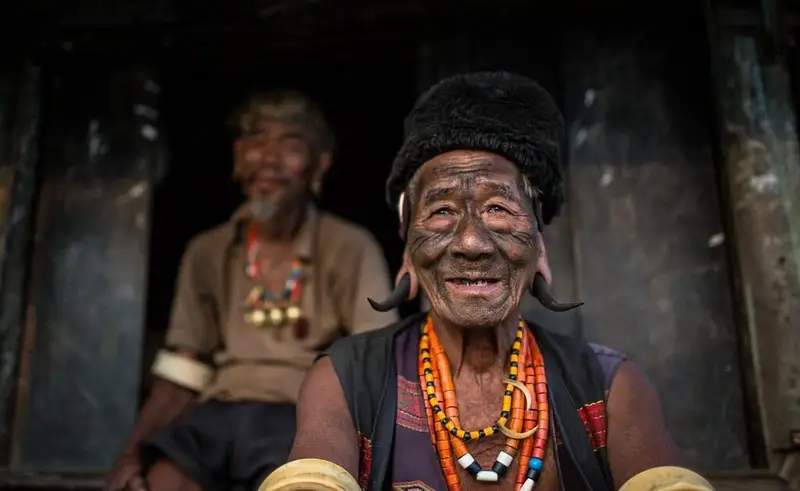In the highlands of South Sulawesi, Indonesia, where emerald-green rice terraces carve their way through mist-shrouded mountains, time does not flow in a linear stream. Here, in the region known as Tana Toraja, the past is not a distant memory but a palpable presence. The dead are not gone; they are merely to makula—those who are sick. They remain part of the family, residing in spirit within the traditional Tongkonan houses, awaiting their final journey. It is within this unique cosmological framework that one of the world’s most profound and startling traditions unfolds: the Manene ceremony, the ritual cleaning and rewrapping of the corpses of ancestors.
To the outside world, it is often sensationalized as the “Walking Dead” ritual. Yet, for the Torajan people, Manene is anything but macabre. It is a sacred act of love, a vibrant family reunion, and a powerful reaffirmation of a bond that even death cannot sever. This ceremony is not a standalone event but a critical thread in the elaborate tapestry of Torajan death culture, centered around the great funeral feast of Rambu Solo’. To understand Manene is to embark to understand the Torajan soul—a worldview where life, death, and ancestry are inextricably woven into a single, continuous existence.
Part 1: The Foundation of Torajan Cosmology
To appreciate the Manene ritual, one must first discard Western conceptions of death. In Toraja, the dominant indigenous belief system is Aluk To Dolo (“the way of the ancestors”), a complex philosophy that dictates all rituals, from those for the living (Rambu Tuka’) to those for the dead (Rambu Solo’). Though many Torajans are now Christian, the Aluk To Dolo remains the bedrock of their cultural identity.
- The Unfinished Death:
In Toraja,a person is not considered truly dead immediately after their heart stops beating. Instead, they enter a prolonged state of being “sick.” The deceased, referred to as To Ma’kambo (“the sick one”), is treated as if still alive. Their body is preserved traditionally with natural herbs and leaves, clothed, and offered food, drink, and betel nut. They are spoken to, included in conversation, and cared for within the family home for weeks, months, or even years. This period lasts until the family can accumulate the resources necessary for the final, and most important, event of a Torajan’s life: the Rambu Solo’ funeral. - The Rambu Solo’ Funeral: The Ascent to Puya
The Rambu Solo’is a massive, days- or even weeks-long funeral ceremony. It is not a somber affair but a grand social event, a moment for the entire community to gather. The primary purpose is to escort the soul of the deceased to Puya, the land of the afterlife, where they will become deified ancestors who can watch over and bless their living descendants.
The scale of a Rambu Solo’ is staggering. It involves intricate rituals, traditional dances, music, and the sacrificial slaughter of dozens, sometimes hundreds, of buffalo and pigs. The buffalo, particularly the prized albino Tedong Bonga, are not merely sacrifices. They are considered vehicles for the soul—the more powerful and valuable the buffalo, the faster and more honorably the soul will reach Puya. The horns of these sacrificed buffalo are then displayed on the front of the family’s Tongkonan house, serving as a permanent public record of the family’s wealth, status, and the honor bestowed upon the deceased.
It is only after a successful Rambu Solo’ that the deceased is considered truly “dead” and their soul has completed its transition to ancestorhood. Their body is then interred in a final resting place, which is often a hand-carved tomb in a cliff face, a natural cave, or a hanging grave. But this burial is not the end of the relationship. It is merely a change in its nature.
Part 2: The Manene Ritual – A Ceremony of Reconnection
The Manene ritual, which typically occurs every one to five years (often in August after the harvest), is the continuation of this eternal relationship. The word “Manene” itself translates roughly to “to care for” or “to clean,” and this definition captures the ritual’s essence perfectly. It is an act of familial devotion.
The Process Unfolded:
- The Auspicious Call: The process begins with a family decision, often guided by a traditional elder or a to minaa (a ritual specialist). They will determine an auspicious date for the ceremony. The entire extended family, including those who have migrated to other parts of Indonesia, will be summoned. Manene is a powerful force of familial cohesion, compelling a gathering that might not otherwise happen.
- The Journey to the Cliff-Side Graves: On the appointed day, the family, dressed in their finest traditional clothes, makes a solemn yet anticipatory journey to the burial site. These sites are often dramatic and breathtaking. The Londa and Lemo burial cliffs are prime examples, with wooden effigies called Tau Tau, carved in the likeness of the deceased, staring out from balconies carved into the rock face. The air is thick with a sense of sacred history.
- The Exhumation: With great care and reverence, the family opens the tombs or retrieves the coffins from their rocky niches. In some areas, particularly in the more remote villages, the deceased are not buried in coffins but are simply wrapped in layers of cloth and placed on ledges inside sacred caves. The atmosphere is one of focused respect, not fear.
- The Act of Love: Cleaning and Grooming: This is the heart of the Manene ritual. The family gently unwraps the cloth shrouds of their ancestors. Using soft cloths, brushes, and sometimes other tools, they meticulously clean the remains, dusting off the accumulated dirt of the years. The highland climate of Tana Toraja often leads to natural mummification, which makes this process possible. The bones are cleaned, and the desiccated tissues are cared for with the same tenderness one would show a living elder.
Then comes the act of re-clothing. The old, decayed garments are removed and replaced with brand new, fine fabrics—often modern clothes, but sometimes traditional textiles. For the Toraja, this is a profoundly symbolic act. It is a way of providing for their ancestors, ensuring they are comfortable and dignified in their eternal rest. It is a daughter brushing her father’s hair, a grandson changing his grandfather’s shirt—familiar acts of care transposed onto a sacred plane. - The “Walk” of the Ancestors: The most visually striking aspect for outsiders, and the one that earns the ritual its “Walking Dead” moniker, occurs in some villages. After being cleaned and dressed, the bodies are sometimes symbolically “walked” along paths. Family members will support the corpse, often using long bamboo poles threaded through the cloth wrappings to guide them. This act is deeply symbolic. It represents leading the ancestor back to their home, their Tongkonan, or simply taking them for a “walk” to see how the village has changed. It is a powerful, physical manifestation of the belief that the ancestor is still present and active within the community.
- The Family Reunion and Feast: The cleaned ancestors are then propped up in a place of honor, often within the burial cave complex or a special area nearby. This is the moment for the family reunion. The living gather around their ancestors, sharing news, updates, joys, and sorrows. They speak to them directly: “Mother, your youngest grandson has just graduated from university.” “Father, we have rebuilt the rice barn.” They seek blessings for new ventures and thank them for their protection. It is a conversation across the veil. This is accompanied by feasting, laughter, and the strengthening of familial bonds among the living.
- The Return to Rest: After the ceremony, which can last for several days, the ancestors are carefully returned to their coffins or resting places. The tombs are resealed, often with new offerings left behind. The family departs with a renewed sense of connection, having fulfilled their sacred duty and reinforced the cosmic order.
Part 3: The Deeper Meanings – More Than a Ritual
The Manene ceremony is a dense symbolic act, carrying multiple layers of meaning that sustain the Torajan social and spiritual universe.
· The Interconnectedness of Life and Death: Manene is the ultimate expression of the Torajan belief that death is not an end but a transition. The care for the physical body long after death demonstrates that the person remains a member of the family unit. The cycle of life, death, and ancestral veneration is a continuous, unbroken circle.
· Siri’ – The Code of Honor and Shame: At the core of Torajan culture is the concept of Siri’, a powerful sense of honor, self-worth, and social duty. To neglect one’s ancestors is a profound source of pakkasiri’ (shame). Performing the Manene ritual is a public demonstration that the family is honorable, dutiful, and upholds the traditions of their forebears. It solidifies their social standing within the community.
· Ancestors as Active Agents: The ancestors in Toraja are not passive memories. They are active, spiritual beings who can influence the world of the living. By caring for their physical remains, the living ensure the ancestors’ contentment. A happy ancestor is a benevolent one, who will provide good harvests, health, and prosperity. Neglect, however, could lead to misfortune, as the ancestor might become displeased. Manene is, therefore, a form of spiritual maintenance.
· Cultural Preservation in a Changing World: In an era of globalization and modernization, where younger generations often migrate for work, traditions like Manene serve as a powerful anchor. The ritual forces a return to the homeland, a re-engagement with the Tongkonan, and the oral transmission of stories and customs. It is a bulwark against cultural erosion, ensuring that the Aluk To Dolo continues to breathe and thrive.
Part 4: The Modern Context and the Gaze of the Outsider
The Manene ritual has not remained untouched by the modern world. Two significant forces are now part of its reality: tourism and Christianity.
Tourism: Tana Toraja is one of Indonesia’s premier tourist destinations, and the Manene ceremony is a major draw. This has created a complex dynamic. On one hand, tourism provides a significant source of income for local communities, validating their culture on a global stage and giving them an economic incentive to preserve it. On the other hand, it risks turning a sacred, intimate family moment into a public spectacle.
The clicking of cameras, the presence of strangers, and the potential for disrespectful behavior can be intrusive. Ethically-minded tour operators now emphasize the importance of discretion, maintaining a respectful distance, and following the guidance of local families. The challenge for Torajans is to navigate this foreign interest without compromising the profound spiritual integrity of the ritual.
Religion: The majority of Torajans are now Christian, a result of vigorous missionary work in the 20th century. This has created a fascinating syncretism. Many Christian Torajans have seamlessly integrated the Manene ritual into their faith. They see no contradiction; the ritual is viewed not as pagan worship but as a cultural expression of honoring one’s father and mother, a commandment found in the Bible. The prayers might be Christian, but the actions—the cleaning, the dressing, the feasting—remain deeply Torajan. This adaptability showcases the incredible resilience of the tradition.
Conclusion: An Eternal Conversation
The Manene ceremony of Tana Toraja is far more than an exotic curiosity. It is a profound philosophical statement about the human condition. It challenges us to reconsider our own relationship with mortality, ancestry, and the bonds of family. In a world that often encourages us to forget the past and move on, the Torajan people choose to remember, to care, and to include.
They teach us that death does not have the power to erase love or obligation. Through the meticulous, tender act of cleaning the bones of their forebears, they engage in an eternal conversation between generations. It is a ritual that affirms that as long as we are remembered and cared for by those who come after us, we are never truly gone. In the misty highlands of Sulawesi, the dead are not a shadow from the past; they are quiet, enduring participants in the vibrant, ongoing story of the living. The Manene ceremony is, ultimately, a beautiful, powerful, and humbling testament to the enduring power of memory and the unbreakable chains of love.












